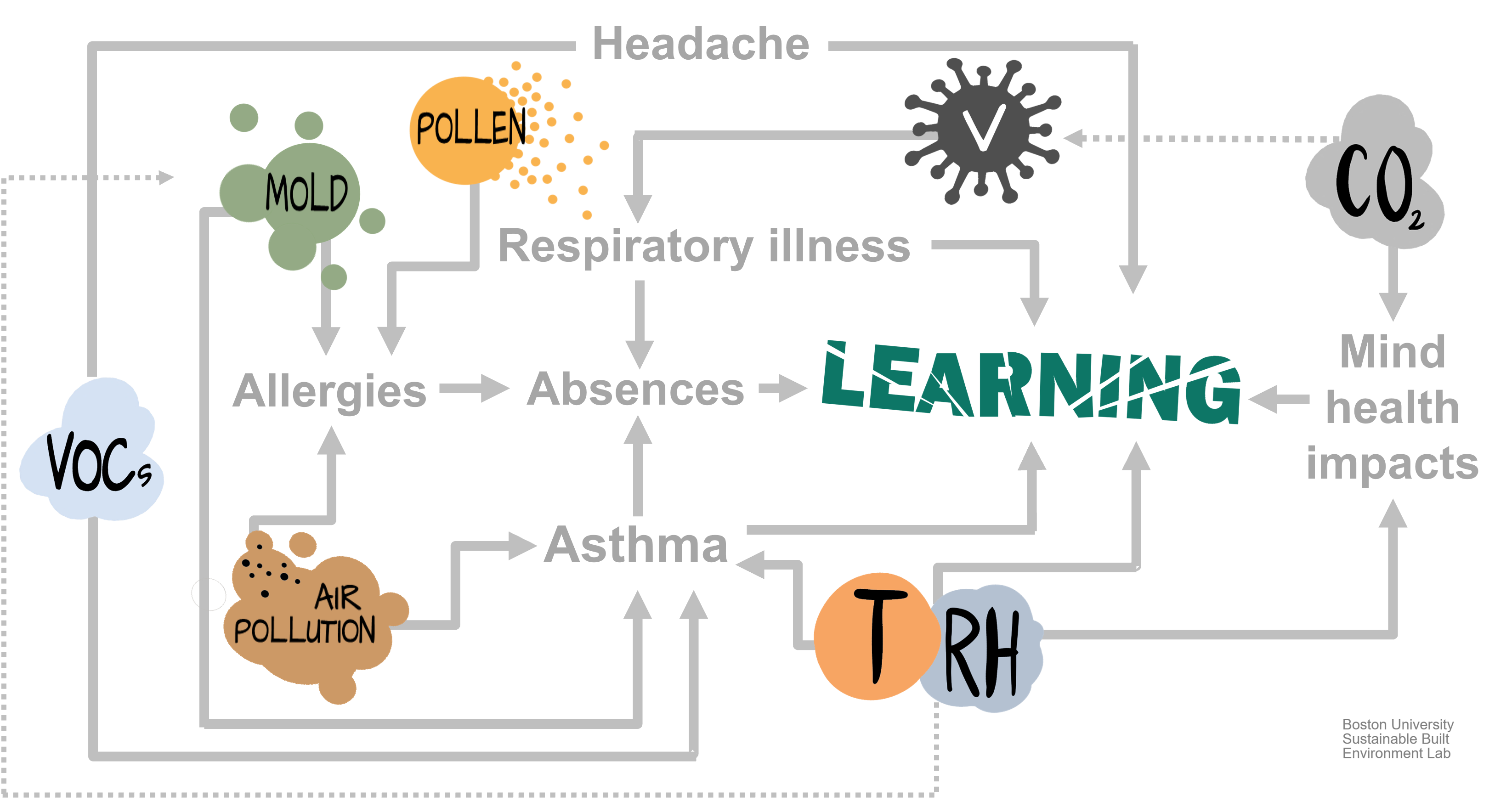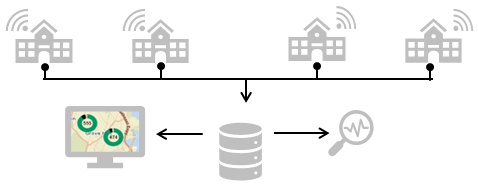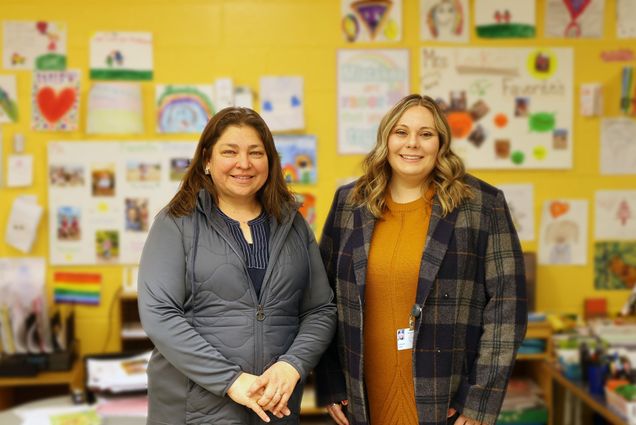
The CHESS project, led by researchers at Boston University, uses data-driven, community-engaged, actionable research to promote healthy indoor air quality, sustainability, and climate resilience in schools.
Publications:
-
M. Pilar Botana Martinez, Priam Dinesh Vyas, Katherine H. Walsh, Lauren Main, Lauren Bolton, Yirong Yuan, Masanao Yajima, M. Patricia Fabian, Rethinking heat in thousands of school classrooms through continuous monitoring and novel exposure metrics, Indoor Environments, Volume 2, Issue 3, 2025, 100105, ISSN 2950-3620, https://doi.org/10.1016/j.indenv.2025.100105.
- Beverly Ge, Koen Tieskens, Priam Vyas, Maria Pilar Botana Martinez, Yirong Yuan, Katherine H. Walsh, Lauren Main, Lauren Bolton, Masanao Yajima, Maria Patricia Fabian, Decision tools for schools using continuous indoor air quality monitors: a case study of CO2 in Boston Public Schools, The Lancet Regional Health – Americas, Volume 48, 2025, 101148, ISSN 2667-193X, https://doi.org/10.1016/j.lana.2025.101148.
- Yirong Yuan, Masanao Yajima, Jinho Lee, Katherine H. Walsh, Brenden Tong, Lauren Main, Lauren Bolton, M. Patricia Fabian, Estimating air exchange rates in thousands of elementary school classrooms using commercial CO2 sensors and machine learning, Indoor Environments, Volume 2, Issue 2, 2025, 100083, ISSN 2950-3620, https://doi.org/10.1016/j.indenv.2025.100083.
Reports and Stories:
- Storymap: Indoor Environmental Quality (IEQ) and Learning in Schools (2025) https://arcg.is/1rG58m1
- Report: Kyleigh Gunn, M. Pilar Botana Martinez, M. Patricia Fabian (2025). Toward healthier air in schools The state of indoor air quality programs in K-12 schools in the U.S. & findings to guide action, 2024
- Story: Professor Partners with Boston Public Schools to Study Classroom Air Quality https://www.bu.edu/sph/news/articles/2024/professor-partners-with-boston-public-schools-to-study-classroom-air-quality/
- Story: Fresher Air, Smarter Schools: SPH Researchers Share Novel Method for Monitoring Indoor Air Quality https://www.bu.edu/sph/news/articles/2025/fresher-air-smarter-schools-sph-researchers-share-novel-method-for-monitoring-indoor-air-quality/
Videos
- BU-BPS research partnership (2025) https://www.youtube.com/watch?v=mhC2UyD615E 3 min
- BU-BPS research partnership (2024) https://www.youtube.com/watch?v=ySIQHQDpYpE 2 min
How Classroom Air Quality Affects Students’ Health and Learning
- Indoor Environmental Quality (IEQ) refers to the presence of substances such as mold, pollen, and pollution in the air, plus qualities such as noise and temperature. Research has demonstrated that good IEQ is key to students’ health and learning (Jones, 2024).
This graphic demonstrates pathways from exposure to indoor environmental stressors to reduced learning. These pathways are relevant to teachers and can impact teaching quality in similar ways.

School Buildings Play a Key Role in Classroom Air Quality
With students spending approximately 6.5 hours a day in schools, IEQ in classrooms is a growing public health concern.
- To achieve good IEQ, school buildings must be well insulated and have mechanical ventilation, heating, cooling and filtration systems (HVAC). (U.S. Environmental Protection Agency, 2023)
- More than 41% of US school districts – lack adequate HVAC systems to ensure good classroom IEQ. (U.S. Government Accountability Office, 2020)
Viruses, mold, air pollutants, volatile organic compounds, high temperatures, and relative humidity are just some of the many environmental stressors found in classrooms. People, cars, buildings, and climate contribute to the generation and accumulation of these stressors in classrooms. Currently, there are limited standards for indoor environmental quality in schools, although many schools follow guidelines such as EPA Tools for Schools.


If you cannot measure IEQ, you cannot improve it
A first step in improving IEQ is knowing what the conditions are in classrooms. Since the pandemic, many schools have increased environmental monitoring in their buildings. Boston Public Schools installed approximately 4,400 IEQ monitors in their classrooms. The monitors help administrators promptly notice and address issues. The IEQ classroom data is publicly available and has also been used to support funding applications for school IEQ improvements.

Accurately measuring IEQ helps us improve student health & learning
Schools need to balance IEQ, SARS-CoV-2 transmission, and energy management goals. Informing these needs based on the billions of data points generated by the monitors is complex and requires strong building science, environmental health, and data analytics expertise.
We’re collaborating with Boston Public Schools to create data analytics to advance IEQ in all schools across the district.
Our CHESS team at BU’s Sustainable Built Environment Lab is:
- Turning school data into meaningful information
- Developing new tools to manage
- Analyzing and visualizing IEQ data trends
- Studying how IEQ affects students health and learning
- Informing school policies and investments
The Sustainable Built Environment Lab (SBEL) is located in the Department of Environmental Health at Boston University School of Public Health.
If you’d like to collaborate or learn more, please email us at sustainableschoolsBU@gmail.com
Illustrations: Pilar Botana Martinez

